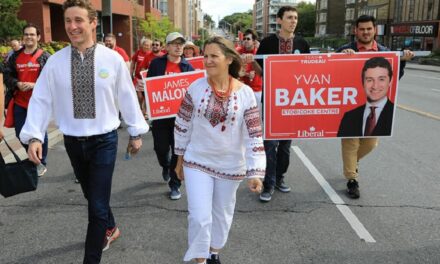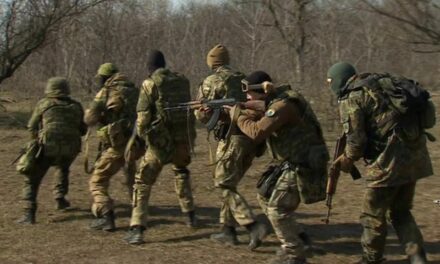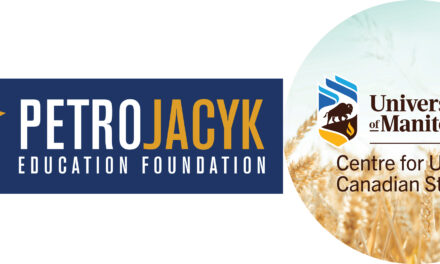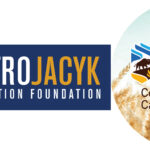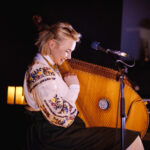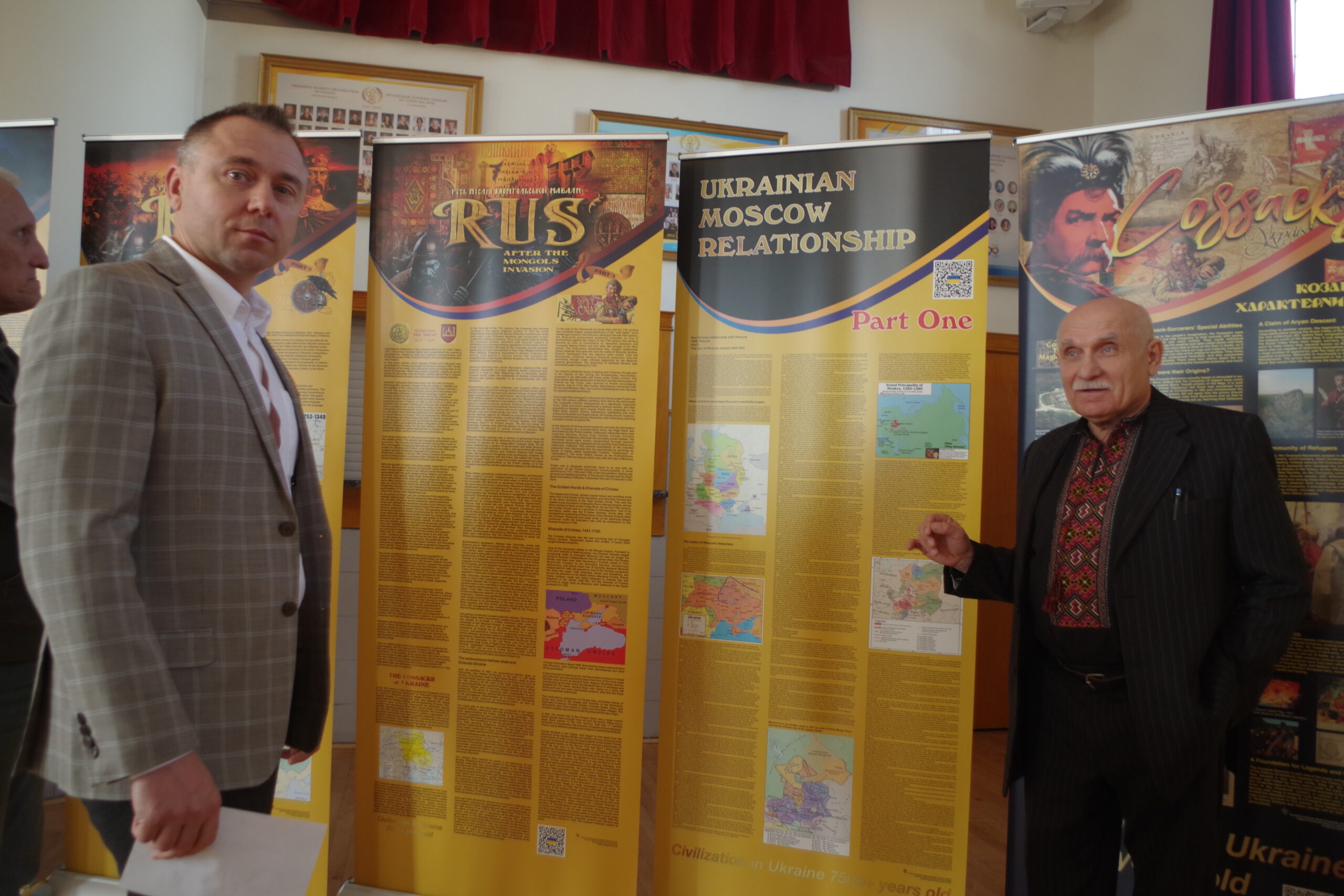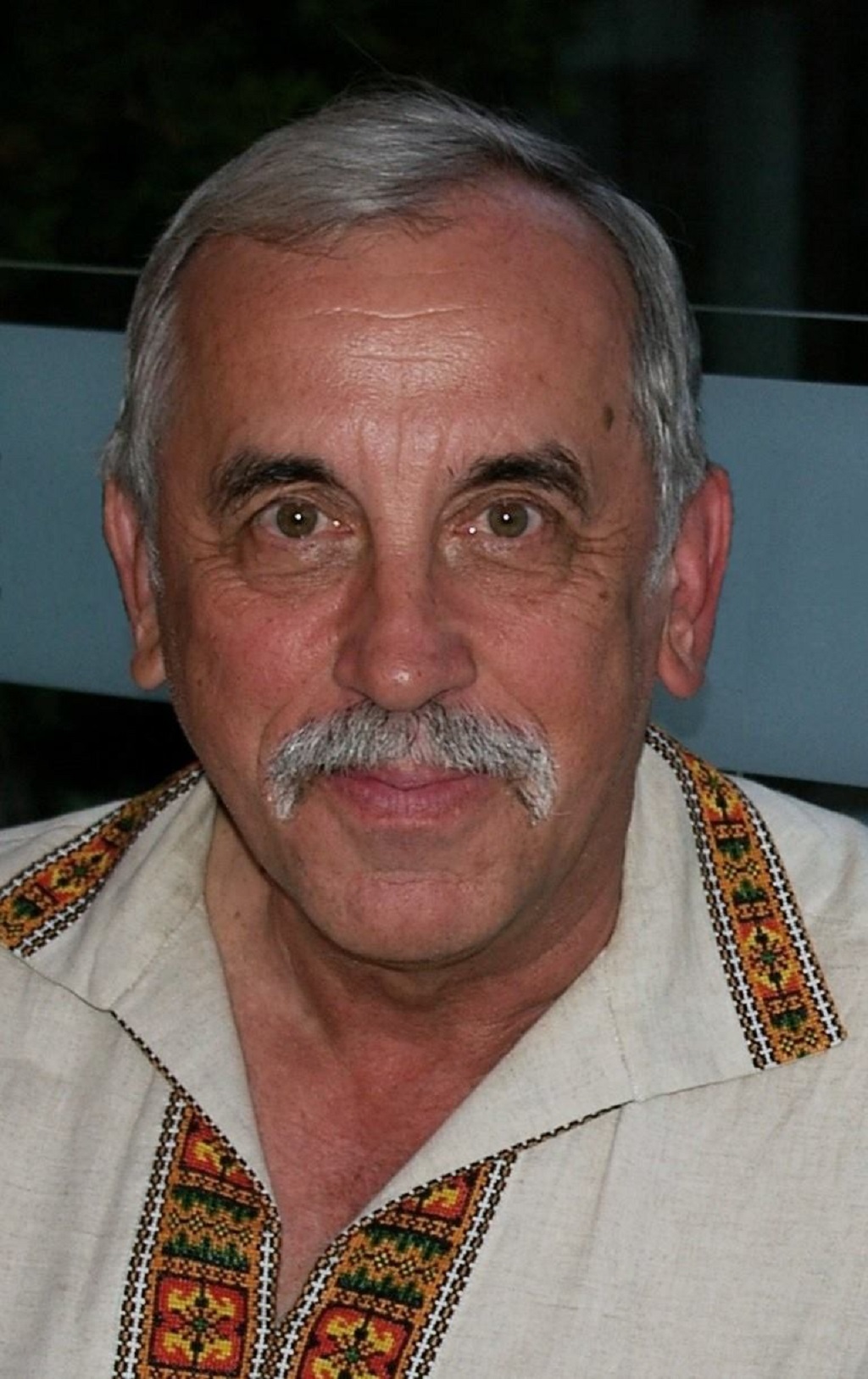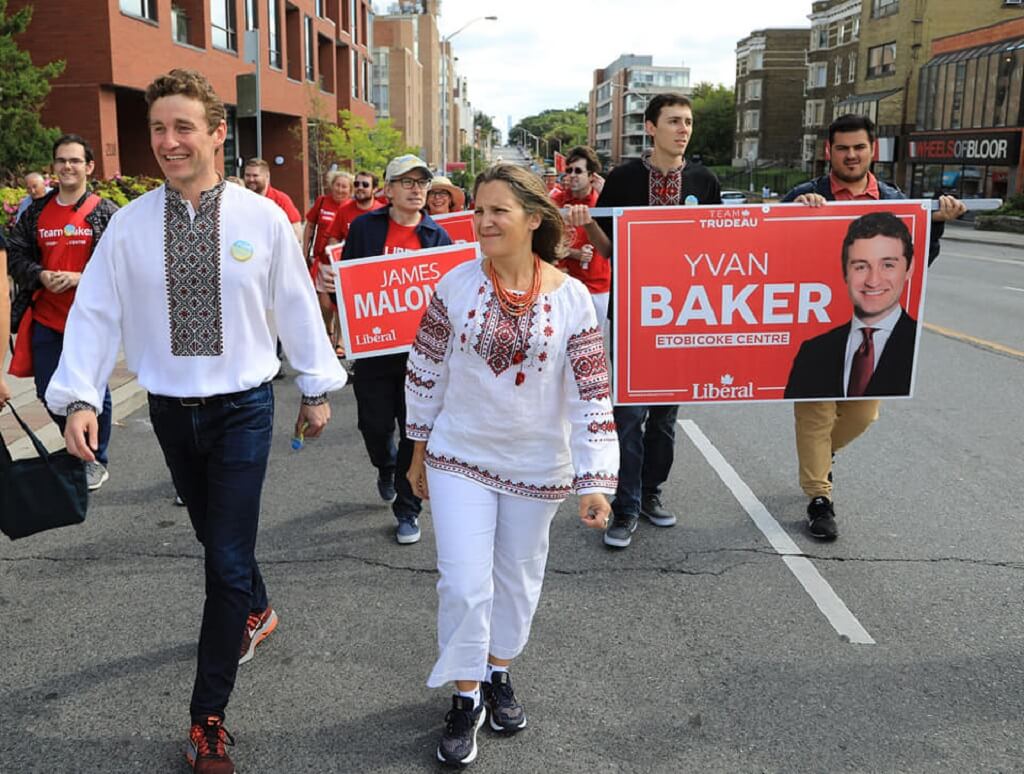Marco Levytsky, Western Bureau Chief.
The Ukrainian National Federation, Edmonton Branch, together with the Organization of Ukrainian Women, Edmonton Branch put on a unique exhibit of Ukrainian civilization dating back more than 7500 years at the UNF Hall, March 16-17.
“It’s the first of its kind in the world,” Mykola Vorotylenko, the creator of the exhibit, told New Pathway – Ukrainian News. “They don’t have one in Ukraine, they don’t have one in Canada.”
Vorotylenko says it took him 20 years to research, and one-and-a half to put it all together for display. Although he studied engineering in school he was always interested in history. But growing up in the USSR he was subjected to the distorted Russian version of Ukraine’s history. It was only when he moved to Canada, and met the late Luba Feduschak who brought him into UNF and introduced him to its library, that he was able to discover the real history.
“For me and Tamara (his wife) a library is like water for a fish,” he says.
Among the volumes he cites as opening up his eyes to the real history of Ukraine are Ivan Herasymovych’s book on the 1921-22 Holodomor in Ukraine, “Isttoriia Pivnichnoyi Chornomorshchyny” (History of the Northern Black Sea Region) by Mykola Arkas, “Korin’ bezmertnoyi Ukrayiny” (The Roots of Immortal Ukraine) by Volodymyr Paik and Ukrayinets’ Moskvyn” (Ukrainian Muscovite) by Pavlo Shtepa.
The 25 panels in the exhibit were painstakingly designed and created by artist Valeriy Semenko. The full set can be viewed at https://unfedmonton.ca/en/civilization-in-ukraine-7500-years-old/). The first two contain a cover and bibliography. Although the title of the exhibit refers to 7500+ years of civilization in Ukraine the chronology opens 20,000 years ago with the mythical country of Aratta (Panel 3), described in Sumerian legends, which some say was in modern-day Ukraine and others in modern-day Turkey. Vorotylenko places Aratta in Ukraine on the basis of the discovery of the Kamyana Mohyla (Stone Grave) archaeological site in the Molochna River valley, about a mile from the village of Terpinnia, Zaporizhzhia Oblast. The site contains petroglyphs, carvings on stone (usually of animals or hunting scenes, like the Caves of Altamira in Spain).
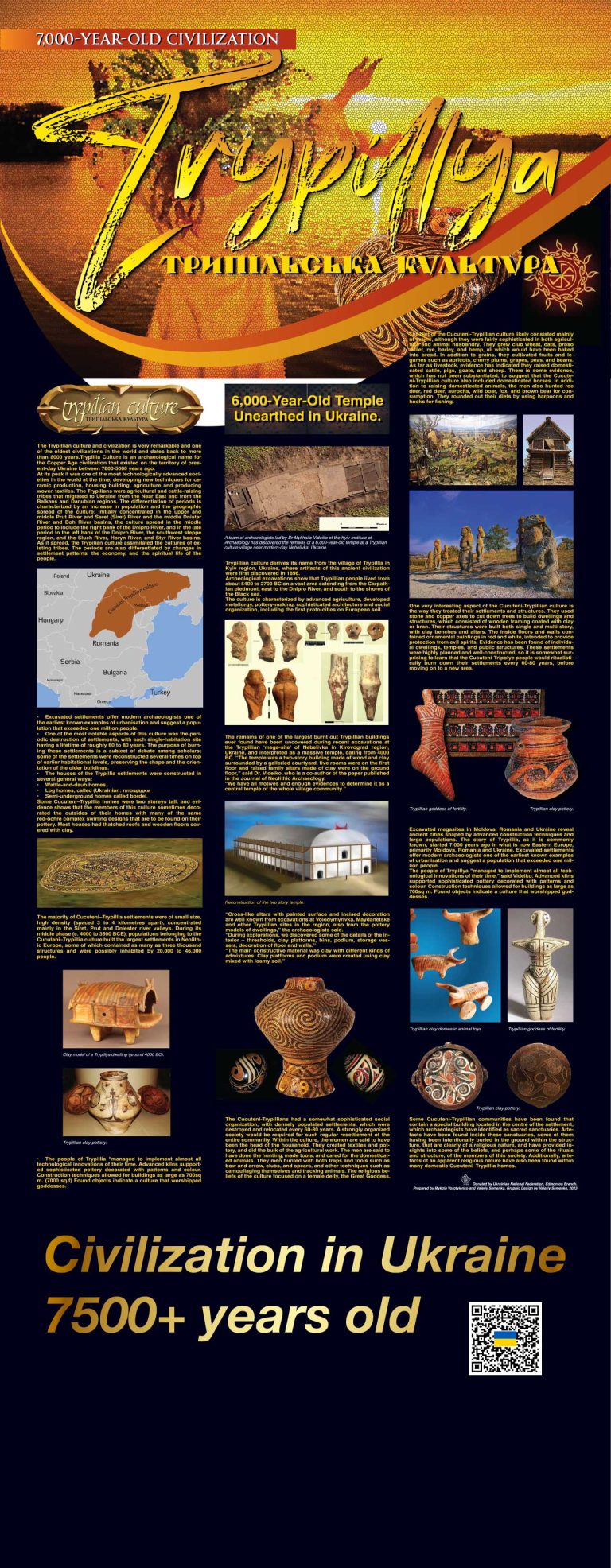
It continues with the Trypyllian culture (Panel 4), which flourished in Ukraine about 7500-5000 years ago and is best noted for its red-brown pottery with swirling patterns and intricate designs which are reproduced even today. Svitlana Molebenska and Vitaliy Storozhuk prepared the mock-up for the Trypillian panel,
Throughout ancient history Southern and Northern Ukraine developed separately due to their ecosystems. The north is woodland, while the south is part of the Great Steppe a vast expanse of grassland that stretches from Mongolia to Hungary. Numerous nomadic people traversed this landmass throughout history leaving their archeological mark on Ukraine.
Thus, the earliest states in Southern Ukraine were established by equestrian nomadic peoples of Iranian origin – the Cimmerians (1200-700 BC, Panel 5), Scythians (700-300 BC, Panels 6-7), and Sarmatians (300 BC to 400 AD, Panel 8). Panels 9 and 10 outline the stories of several peoples who inhabited Southern Ukraine over a 1,000 year interval from the third to 14th centuries AD. These include the Germanic Goths, who came through Ukraine in the third and fourth centuries before proceeding to raid and eventually replace the Western Roman Empires with their own kingdoms. The rest, all of whom were Asiatic in origin, were the Huns (4 5th centuries), Avars (6-9th centuries), and Magyars (862-895), all three of whom eventually settled in what is modern-day Hungary, the Volga Bulgars (7th century) who founded modern-day Bulgaria and assimilated with the Slavic population which had settled earlier, and three Turkic-speaking peoples – the Khazars, who established an empire that lasted from 650-969 encompassing much of Ukraine right up to Kyiv and were noted for having adopted Judaism as their religion; the Pechenegs (9-11th centuries), the Cuman, known in Ukrainian as Polovtsi (11-13th centuries, who replaced the Pechenegs and were in turn themselves replaced by the Mongols.
Panel 10 deals with our own ancestors, the Slavs whose original homeland is considered by most historians to be the Polissia region of Northen Ukraine and Southern Belarus. They first come to historical attention in the 1st century AD through the writings of Roman chroniclers Pliny the Elder and Tacitus who refer to them as Veneti. The first Slavic and proto-Ukrainian state was formed in the northwest Black Sea region encompassing modern-day-Moldova and Central Ukraine by the Antes in the 6th century. It was around the same time that the Slavs began to migrate from their homelands Westward, Southward, and Eastward establishing the three branches of the Slavic family – West Slavs (today’s Poles Czechs and Slovaks), South Slavs (Bulgars, Slovenes, Croatians, Bosnians, Serbians, Montenegrins and Macedonians) and East (Ukrainians, Belarusians, Muscovite-Russians).
In the 9th century Swedish Vikings, known as the Varangians established Kyivan Rus, named after its capital city and the Varangian tribe which established the princely dynasty. They quickly assimilated with the indigenous Slavic population and flourished during the 10th and 11th centuries adopting Christianity under Prince St. Volodymyr the Great and achieving a cultural apex far ahead of Western Europe under his son Yaroslav the Wise. That is covered in Panels 11-12. But fratricidal war between the princes of Rus led to its disintegration into several separate principalities until the Mongol invasion of 1240 put the final nail into its coffin.
Panels 13-15 cover the lands of Rus (Ruthenia in Latin) following the Mongol invasion. The Western Ukrainian principality of Galicia-Volyn played a very prominent role in European affairs from the 13th century to 1349 when it was divided between Poland and the rising Grand Duchy of Lithuania, Ruthenia and Samogitia which also encompassed Central Ukraine and Belarus. When Lithuania merged with the Kingdom of Poland under the Lublin Union of 1569, Belarus remained under the control of the Lithuanian Duchy, while Ukraine fell under the rule of Poland which began a process of Polonization. Southern Ukraine, meanwhile, fell under the control of the Tatar Golden Horde which was the westernmost successor state of the former Mongol Empire.
Panel 16 is entitled “Ukrainian Moscow Relationship: Part One” and marks the birth of Muscovy-Russia in 1169. During the disintegration of Kyivan Rus the principalities on the northeast fringe of the country began to develop as a separate ethnic and cultural entity which came to a head in that year when the most inappropriately named Prince Andrei Bogolyubsky of Vladimir-Suzdal sacked Kyiv and moved the capital to his own city of Vladimir, effectively separating from Rus’-Ukraine. In 1263, Prince Danylo inherited the tiny Duchy of Moscow as an appendage to Vladimir-Suzdal and became a vassal state of the Mongol Empire gleefully adopting its despotic traditions.
Panel 17 covers the history of the Zaporizhian Kozaks and the creation of their 17th century state. Panels 18-20 continues the history of Russian oppression throughout the centuries ending with the present day.
The remaining five panels deal with cultural matters. Number 21 focuses on the Ukrainian language. Nataliia Nalyvaiko assisted in preparing this one. The Ukrainian language belongs to the Slavic family which in turn belongs to the Indo-European group which includes virtually all European languages with the exception of the Finnish, Estonian, Hungarian and Basque as well as those spoken on the Iranian plateau, and the northern Indian subcontinent. It is hypothesized that at all these languages derived from a single language known as Proto-Indo-European spoken from approximately 4500 BC to 2500 BC on the territory of what is now Southern Ukraine, as is noted on the panel.
The remaining four panels, which were prepared with the assistance of Vorotylenko’s wife Tamara deal with Pysanky, Embroidery (two panels) and the Petrykivka decorative painting.
Vorotylenko says it is imperative for people to learn the true history of Ukraine and not the fabrications espoused by Muscovite academics.
And what history shows is that “the most important mission of Ukraine was and remains establishing the first line of defence against the onslaughts of various nomads from the east or the north. Having stood as this first line of defence against the invaders, Ukraine has given Europe both the time and the chance to mobilize for its own defence. And that is what Ukraine is doing today.”
Share on Social Media






